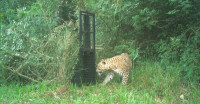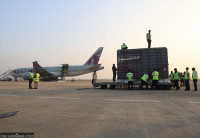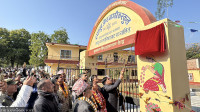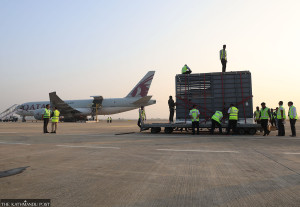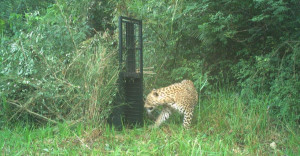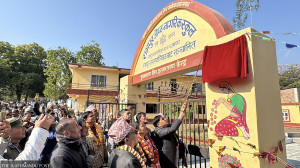Lumbini Province
1,089-metre Siddhababa tunnel achieves breakthrough
Even if the contractor, China State Construction Engineering Corporation, sticks to the timeline, the tunnel will take over a year before vehicles can operate.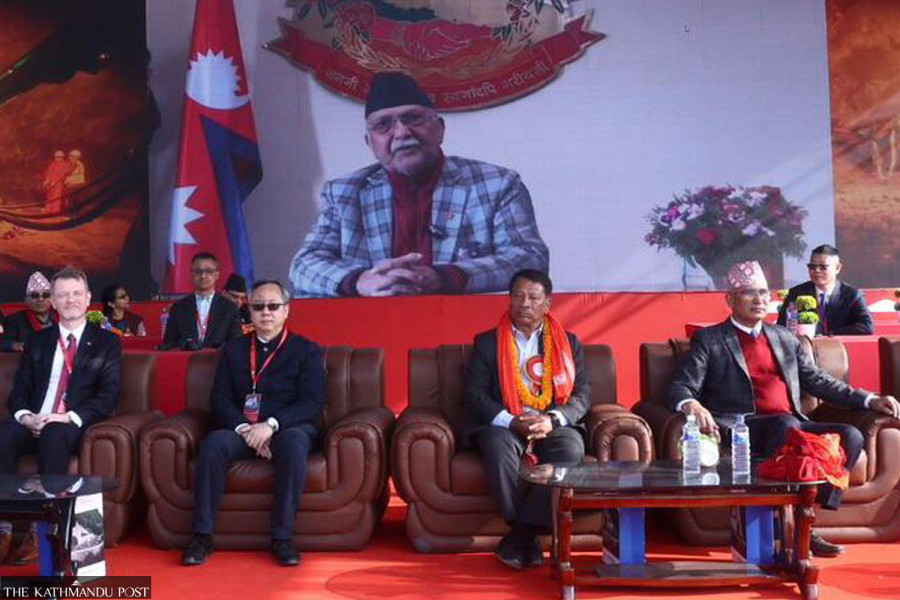
Madhav Aryal
The Rs7.34 billion Siddhababa tunnel project achieved a breakthrough on Friday.
The main tunnel located in ward 3 of Tinau Rural Municipality of Palpa district, achieved the breakthrough after a virtual address by Prime Minister KP Sharma Oli from Kathmandu. Although the prime minister had planned to attend the function in person, the plan was put off at the last moment due to his health issues.
Only 1.8 metres of the 1,089-metre-long tunnel was left to be excavated for the breakthrough.
Addressing the event virtually, Prime Minister Oli said the tunnel project would provide a much-needed relief to travellers on the route, who have long endured landslide-induced accidents. He said the project would facilitate safer travel, strengthen social and economic ties, and enable the exchange of goods and services.
Referring to last year’s breakthrough of the Nagdhunga-Naubise tunnel as Nepal’s entry into the era of tunnels, the prime minister said that the environment of fear during travel had ended, allowing for safer and shorter journeys.
“The breakthrough of the tunnel is a moment of joy for the entire country. Nepal is no longer as remote as it once was. We need to make it even more accessible,” said Prime Minister Oli. “The government is committed to rapid development and good governance. We will also seek support from others and build our country. The government’s focus will remain on initiatives that benefit the nation, and our efforts are directed towards this goal.”
The breakthrough event was attended in person by Deputy Prime Minister and Minister for Urban Development Prakashman Singh, Deputy Prime Minister and Minister for Finance Bishnu Paudel, Minister for Physical Infrastructure and Transport Devendra Dahal, and Secretary of the Ministry Keshav Kumar Sharma, among others.
According to the Siddhababa Tunnel Project Office, the project’s physical progress reached 40.18 percent, while financial progress stood at 39.90 percent at the time of the breakthrough.
A two-lane main tunnel spanning 1,089 metres has been constructed, said Project Chief Krishna Raj Adhikari. He said the main tunnel will have a width of 10.5 metres and a height of around 7 metres. Including the lining, the total length of the tunnel will be 1,126 metres. Tunnel lining is a permanent structure that supports the surrounding rock and prevents the tunnel from collapsing.
Although the tunnel has achieved a breakthrough, completing the lining and adjusting the slope will take time. According to the project, even if the contractor adheres to the timeline, it will take another year for vehicles to begin operating.
Project Chief Adhikari said three evacuation tunnels have been constructed to rescue passengers during emergencies. The first tunnel is 151 metres long, the second is 161 metres, and the third spans 130 metres.
The first bypass tunnel had achieved its breakthrough on September 20 last year, the second on December 22, and the third on September 11.
Helipads are planned for construction at both ends of the tunnel. Remaining tasks include lining, ventilation, wall concreting, waterproofing, road construction, lighting installation, oxygen systems, and fire safety measures, said Information Officer Sabita Gyawali.
The China State Construction Engineering Corporation was awarded the project tender worth Rs7.34 billion on February 17, 2022. According to the contract terms, construction must be completed by March 22, 2027. The tunnel excavation work began in December last year.
The contractor is also tasked with building a rock shed, rock fall netting, and slope protection structures on the outer side of the tunnel.
A rock shed is a protective structure built over a road or tunnel to shield it from falling rocks and debris. This protective covering redirects the falling material safely away, reducing the risk of accidents in landslide-prone areas.

According to the agreement, the tunnel must be completed within 25 months from now. The construction company will operate and maintain the tunnel for five years after its completion.
The project is being constructed under the engineering, procurement, and construction (EPC) model, where a single contractor is responsible for all components, such as design, engineering, construction, and procurement.
The Siddhababa-Dovan road section is the main link between more than a dozen districts in the plains and hills. The hill districts, including Palpa, Gulmi, Arghakhanchi, Syangja, Kaski, Parbat, and Baglung are connected to the Tarai districts, mainly in Lumbini Province through Rupandehi.
The section, notorious for its dangers, has claimed many lives, prompting the government to construct the tunnel. Once completed, the tunnel is expected to provide safer and more efficient travel along the highway between the districts of Lumbini and Gandaki provinces.
More than 10,000 vehicles ply this road section every day.




 14.12°C Kathmandu
14.12°C Kathmandu
